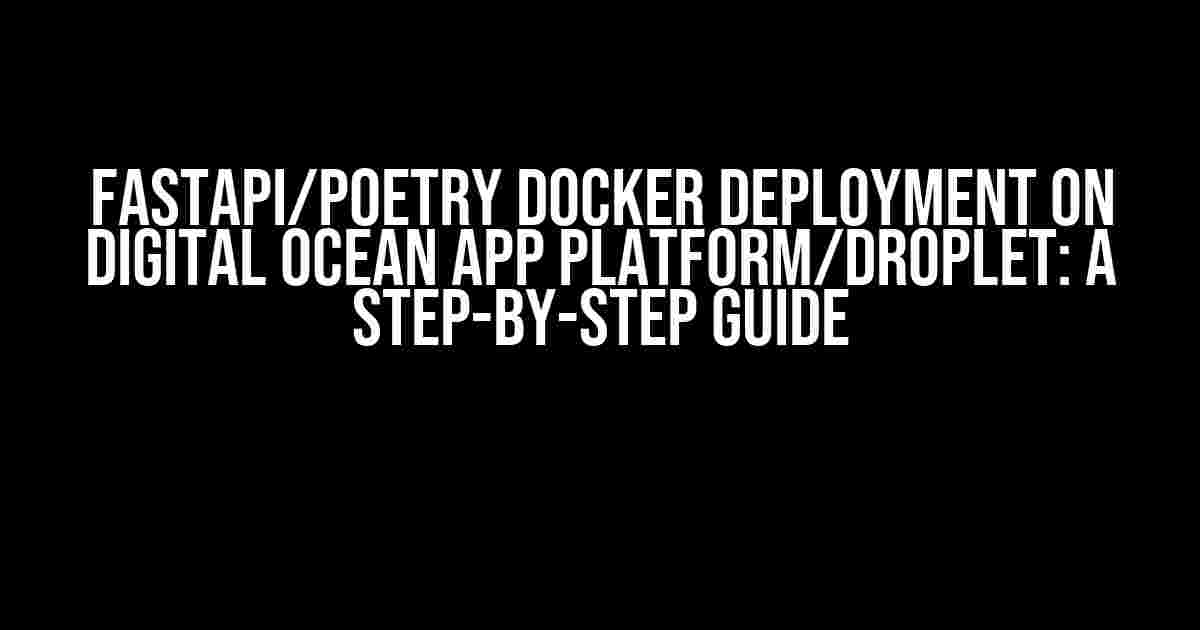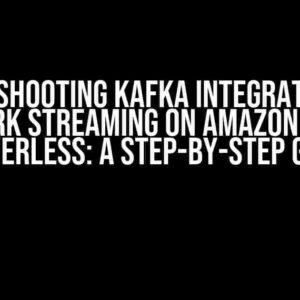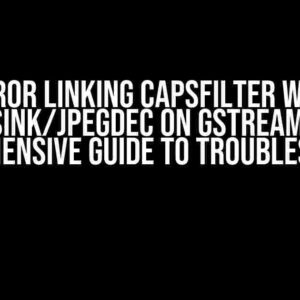Are you tired of navigating the complex world of deploying your FastAPI application on Digital Ocean? Look no further! In this article, we’ll take you on a journey to deploy your FastAPI application using Poetry and Docker on Digital Ocean App Platform and Droplet. Buckle up, and let’s dive in!
- Getting Started
- What is FastAPI?
- What is Poetry?
- Step 1: Create a New FastAPI Project
- Step 2: Initialize Poetry
- Step 3: Install dependencies with Poetry
- Step 4: Create a Dockerfile
- Step 5: Build the Docker Image
- Step 6: Push the Image to Docker Hub
- Step 7: Create a Digital Ocean Droplet
- Step 8: Deploy to Digital Ocean App Platform
- Step 9: Configure the App Platform Environment Variables
- Conclusion
- Bonus: Tips and Tricks
Getting Started
Before we begin, make sure you have the following:
- A Digital Ocean account (sign up for a free trial if you don’t have one)
- Docker installed on your local machine
- Familiarity with FastAPI and Poetry (don’t worry, we’ll cover the basics)
- A code editor or IDE of your choice (we’ll use Visual Studio Code in this example)
What is FastAPI?
FastAPI is a modern, fast (high-performance), web framework for building APIs with Python 3.7+ based on standard Python type hints. It’s designed to be fast, simple, and easy to use.
What is Poetry?
Poetry is a Python package manager that makes it easy to manage dependencies for your project. It’s similar to pip, but with a more intuitive and user-friendly interface.
Step 1: Create a New FastAPI Project
Open your terminal and create a new directory for your project:
mkdir fastapi-poetry-docker cd fastapi-poetry-docker
Next, create a new FastAPI project using the following command:
fastapi create app
This will create a basic FastAPI project structure with a `main.py` file.
Step 2: Initialize Poetry
In your project directory, run the following command to initialize Poetry:
poetry init
Follow the prompts to set up your project with Poetry. For this example, we’ll use the following settings:
project name: fastapi-poetry-docker version: 1.0.0 description: My FastAPI project authors: [Your Name] license: MIT
Step 3: Install dependencies with Poetry
In your `pyproject.toml` file, add the following dependencies:
[tool.poetry] name = "fastapi-poetry-docker" version = "1.0.0" [tool.poetry.dependencies] fastapi = "^0.65.0" uvicorn = "^0.13.4"
Run the following command to install the dependencies:
poetry install
Step 4: Create a Dockerfile
Create a new file named `Dockerfile` in your project directory:
FROM python:3.9-slim WORKDIR /app COPY poetry.lock ./ COPY pyproject.toml ./ RUN poetry install COPY . . CMD ["uvicorn", "main:app", "--host", "0.0.0.0", "--port", "8000"]
This Dockerfile uses the official Python 3.9 image, sets up the project directory, installs the dependencies using Poetry, and copies the application code. Finally, it sets the command to run the FastAPI application using Uvicorn.
Step 5: Build the Docker Image
Run the following command to build the Docker image:
docker build -t fastapi-poetry-docker .
This will create a Docker image with the name `fastapi-poetry-docker`.
Step 6: Push the Image to Docker Hub
Create a Docker Hub account if you don’t have one, and log in to your account using the following command:
docker login
Tag the Docker image with your Docker Hub username and push it to Docker Hub:
docker tag fastapi-poetry-docker:latest/fastapi-poetry-docker:latest docker push /fastapi-poetry-docker:latest
Step 7: Create a Digital Ocean Droplet
Log in to your Digital Ocean account and create a new Droplet:
| Image | Distribution | Plan |
|---|---|---|
| Docker | Ubuntu 20.04 | Basic ($5/month) |
Choose a datacenter region and create the Droplet. Wait for the Droplet to be created and note the IP address.
Step 8: Deploy to Digital Ocean App Platform
Log in to your Digital Ocean account and navigate to the App Platform dashboard:
Create a new app and choose the “Docker” option:
| Image | Environment |
|---|---|
| Production |
Configure the app settings as desired, and create the app. Wait for the app to deploy successfully.
Step 9: Configure the App Platform Environment Variables
Navigate to the App Platform environment variables settings and add the following variables:
| Variable | Value |
|---|---|
| FASTAPI_HOST | 0.0.0.0 |
| FASTAPI_PORT | 8000 |
Save the changes and redeploy the app.
Conclusion
Congratulations! You’ve successfully deployed your FastAPI application using Poetry and Docker on Digital Ocean App Platform and Droplet. You can now access your app using the App Platform URL or the Droplet IP address.
This guide has shown you how to create a new FastAPI project, initialize Poetry, install dependencies, create a Dockerfile, build and push the Docker image, create a Digital Ocean Droplet, and deploy to the App Platform. With this knowledge, you’re ready to take your FastAPI application to the next level!
Bonus: Tips and Tricks
Here are some additional tips and tricks to help you with your FastAPI/Poetry/Docker deployment:
- Use a `.dockerignore` file to exclude unnecessary files from the Docker build process.
- Use environment variables to configure your FastAPI application.
- Implement logging and monitoring using tools like Docker Logs, Prometheus, and Grafana.
- Use a CI/CD pipeline to automate the deployment process.
- Experiment with different Docker image sizes and optimization techniques.
We hope you found this article helpful in deploying your FastAPI application using Poetry and Docker on Digital Ocean App Platform and Droplet. Happy deploying!
Frequently Asked Question
Get ready to dive into the world of FastAPI, Poetry, Docker, and Digital Ocean, where deploying your app is just a few clicks away!
What is the main advantage of using FastAPI over other Python web frameworks for deployment on Digital Ocean?
FastAPI is built for speed, scalability, and security, making it a perfect fit for deploying high-performance APIs on Digital Ocean. Its asynchronous architecture and support for modern Python type hints ensure that your app can handle a large number of concurrent requests, making it ideal for production deployments.
How does Poetry help with dependency management for a FastAPI project on Digital Ocean?
Poetry is a fantastic dependency manager for Python projects, and it shines when it comes to managing dependencies for a FastAPI project on Digital Ocean. It allows you to declare dependencies in a simple and readable format, making it easy to manage and lock dependencies across different environments. This ensures that your app uses the same dependencies in development, staging, and production, eliminating any potential inconsistencies.
What is the role of Docker in deploying a FastAPI app on Digital Ocean, and how does it benefit the deployment process?
Docker containers provide a lightweight and portable way to deploy a FastAPI app on Digital Ocean. By packaging your app and its dependencies into a Docker image, you ensure that your app is isolated from the host system and can be easily scaled, backed up, and restored. Docker also enables effortless rollbacks, giving you peace of mind during deployments. Plus, Digital Ocean’s support for Docker makes it a breeze to deploy and manage your app.
Can I use a Digital Ocean Droplet instead of the App Platform for deploying my FastAPI app, and what are the key differences between the two?
Yes, you can use a Digital Ocean Droplet to deploy your FastAPI app, but it requires more manual effort and expertise. A Droplet is a virtual machine that gives you full control over the underlying infrastructure, whereas the App Platform provides a managed platform that automates many tasks, such as scaling, backups, and rollbacks. With a Droplet, you’ll need to handle these tasks yourself, but you’ll have more flexibility and customization options. The App Platform is ideal for smaller teams or projects that need a more streamlined deployment experience.
What are some best practices to keep in mind when deploying a FastAPI app on Digital Ocean using Poetry and Docker?
Some best practices to keep in mind include: using a consistent naming convention for your Docker image and Poetry project, setting up a CI/CD pipeline to automate builds and deployments, using environment variables to configure your app, and monitoring your app’s performance and logs using Digital Ocean’s built-in tools or third-party services. Additionally, make sure to follow security best practices, such as using secure passwords and limiting access to your app and underlying infrastructure.




